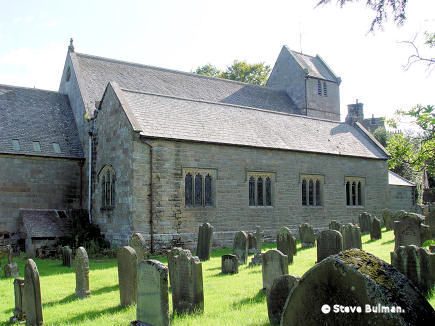chatton parish is bounded on the north by Lowick and Doddington parishes, on the west by Wooler and Eglingham, on the south by Eglingham and Chillingham, and on the east by Bambrough and Belford parishes. It is about seven and a half miles in length by the same in breadth, and has an area of 17,090 acres. Population in 1801, 1135; in 1811, 1,378; in 1821, 1,460; in 1831, 1,632; in 1841, 1,725; and in 1851, 1,765 souls, It comprises the townships of Chatton, Fowberry, Hazelrig, Hetton, Hetton House, Horton, Lyham, and Weetwood, whose returns are included in those of the parish. This district is intersected by the river Till, a rapid stream, which rises southward of the Cheviot Hills, and is fed by various springs from that wild expanse of country, as it encompasses it at a considerable distance, till it falls into the Tweed, below Cornhill. This river flows through a pleasant valley in the midst of a rude, encircling waste, and its banks are adorned by several villages. In the neighbourhood of the Till, the soil is fertile and well cultivated, but the east and west portions of the parish are generally sterile and heathy. Coal and limestone are found in this district.
 chatton, a
township and village in the parish of the same name, is the property of
the Duke of Northumberland, who is also lord of the manor. the village
of Chatton is situated
chatton, a
township and village in the parish of the same name, is the property of
the Duke of Northumberland, who is also lord of the manor. the village
of Chatton is situated
coldmartin township is situated one mile south-east of Wooler, and the principal residents are Richard Henderson, farmer; Mr. Christopher Hopper; and Elizabeth Millican, farmer,
fowberry is a township two miles east by south of Wooler, the property of George Cully, Esq., of Fowberry Tower. This place was the manor and estate of William de Fowberry, in the reign of Edward I, of Robert de Fowberry, in the time of Edward IV, and of William de Fowberry, in 1524. From the Fowberry's, it passed to the Strothers, of Kirk Newton, and about eighty years ago became the property of the family of the present proprietor. fowberry tower, the residence of George Culley, Esq., is pleasantly and romantically situated on the south bank of the Till.
hazelrig township, the property of Lady Stanley, and the executors of William Bayley, Esq., is situated six miles north-east of Wooler, and its principal inhabitants are George Johnson, schoolmaster; James Purvis, blacksmith; and the farmers are George Davison, South Hazelrig; Alexander Ford, and corn miller, Hazelrig Mill; and William Nicholson, North Hazelrig.
hetton township is situated five miles N. N. E. of Wooler, and is the property of Fairfax Fearnley, Esq. It contains the small hamlets called Hetton-Law, Hetton Steads, Coal Houses, and Crook Houses.—The principal residents are John Cuthbertson, joiner, cartwright, and farmer, Coal-Law ; Robert Bowie, farmer, coalowner, and limeburner, Hetton-Law, and Crook House; James Henry, blacksmith; Thomas Henry, farmer, Coal House; and Thomas and Ralph Moffett, farmers, Hetton Steads.
hetton house, a small township three and a half miles E. N. E. of Wooler, is the property of George Culley, Esq., and is occupied by Richard Henderson, farmer.
horton is a township and hamlet the property of George Culley, Esq. This estate was formerly held of the barony of Vesci, for half a Knight's fee, by William de Tuberville, and it afterwards became the property of a junior branch of the Greys of Chillingham, coming ultimately into the possession of the present proprietor. Of the once strong castle of Horton scarcely a vestige now remains. the hamlet of Horton is situated three miles north-east of Wooler.
lyham township is situated six miles E. N. E. of Wooler. The principal residents are Thomas Aitchison, farmer; Ralph Craig, farmer, North Lyham; and David Turnbull, farmer, West Lyham.
weetwood is a township situated two miles north-east of Wooler. An annual fair is held at Weetwood Bank, on Whit Tuesday, when there are very large shows of cattle, horses, and sheep. Servants are also hired at this fair. weetwood hall, the seat of Major Ord, is pleasantly situated on the north bank of the Till.
William Whellan & Co., History of Northumberland, 1855